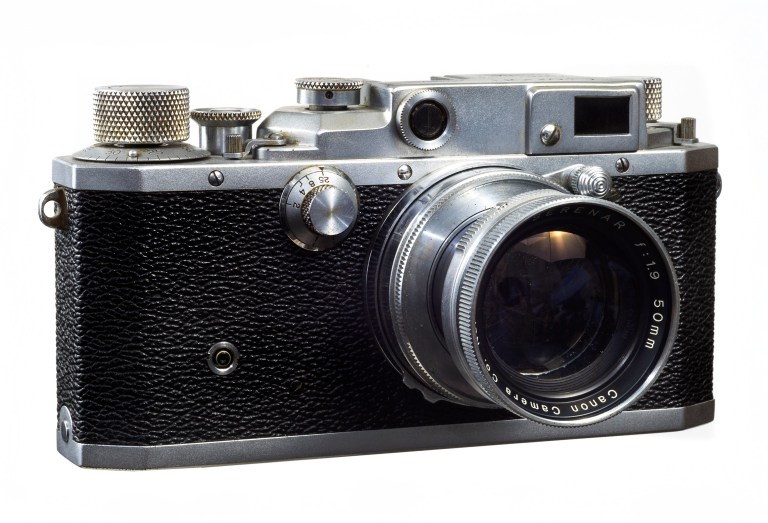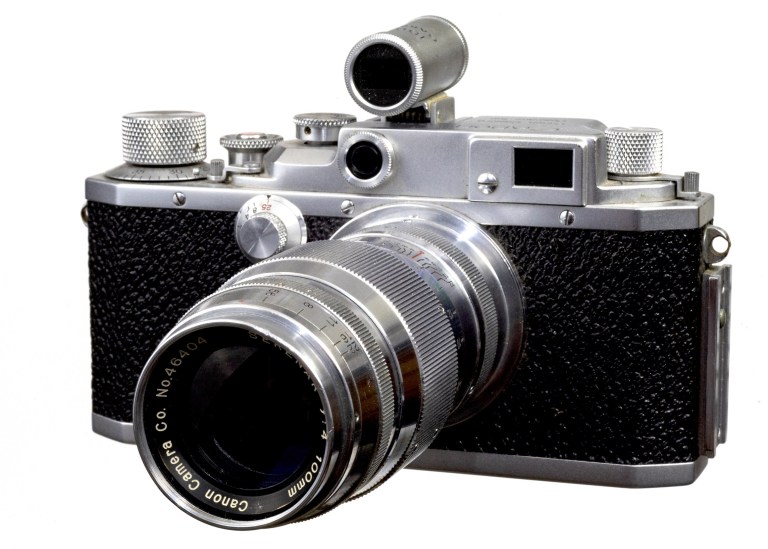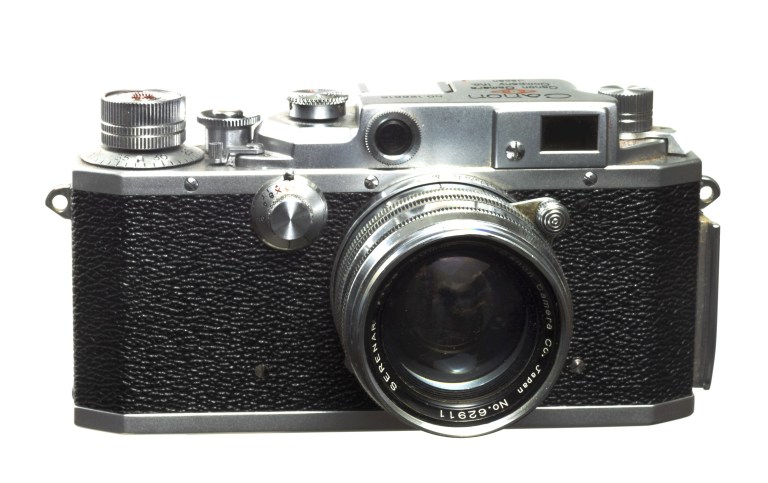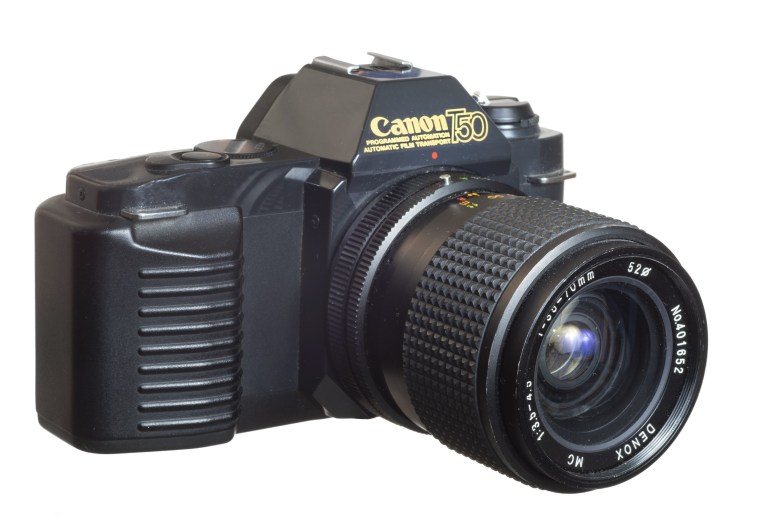Canon has produced cameras since the mid 1930s, but the first commercially successful export model was the 1946 S-II, which received Canon branding in 1947 (example below). This is the oldest Canon camera in our collection. The photos below are of cameras in our collection; we don’t have every model, but have tried to accumulate examples of most evolutionary steps.
Until 1959, Canon exclusively made high-end and professional quality rangefinder cameras. Then they experimented with professional single lens reflex cameras, only to lose-out to Nikon. They later recouped a high-level presence, but not until the digital age did they regain a top-slot.
What is today Canon Inc, one of the world’s leading optics and electronics manufacturers, began in 1934 with a camera prototype called the Kwanon (pronounced canon). The name is adapted from, Kannon, the Buddhist Goddess of Mercy. The design was modified from the popular German Leica II and III designs, but not exact copies.
At the time Nippon Kogaku (now Nikon) was a large optics company, but they did not produce a camera. The leader of the Kwanon project was an obstetrician named Takeshi Mitarai; he had a highly placed relative at Nippon Kogaku who supported the efforts to create the first Japanese camera with a focal-plane-shutter, in a world-class design. Nippon Kogaku built the lens-mount and rangefinder system, supplied the lenses, and may have helped with finance.
In 1937 Precision Optical Industry Co., Ltd. (Seiki Kōgaku Kenkyūjo), was formed, although the first commercially successful camera, the Hansa Canon, began production in ealy 1936. Hansa was a trademark of Omiya Photo Supply, the distributor of the cameras. Not all of the cameras in this era wore the Hansa branding; some identical cameras were produced with just the Canon logo.
In 1939, the design for the Hansa Canon was replaced by the Canon S which was competitive with the Leica III featuring a rangefinder, slow-speed-dial, and several Nikkor interchangeable lens options. However, there was a unique pop-up viewfinder on top of the camera, where Leicas had a seperate window inline with the rangefinder windows. There were also three lower cost models:
Canon J (Junior) without the rangefinder and low speed dial
NS (New Standard) which has the rangefinder, but no low speeds
JS, which has the low speeds, but not the rangefinder.
When war came the company focused on military optics, but after the war they began selling consumer cameras in January 1946, with limited production. Most cameras were adapted from spare parts to make a JII and SI, though only about 100 of the latter high-end cameras were produced.
Canon S-II – Serenar 50mm f/3.5 – Circa 1947
The oldest camera in our collection is the first post-war design, the Canon S-II, which was similar to the pre-war Canon S and 1946 Canon S-I, but was simplified with features from the Canon J. Unlike the Leicas, the rangefinder and viewfinder windows were combined, and the pop-up viewfinder of the S/S I was eliminated. The combined finder was a significant improvement to the Leica design, something that Leica would not offer until the all new Leica M of the mid 1950s.
Early models had the Seiki Kōgaku branding and used the old-style lens mount. Later cameras, like ours, use the Leica M39 mount and have Canon branding.
During the production of the S-II Canon began to offer its own Serenar line of lenses, and reduced the dependence on Nippon Kogaku. Correspondingly, Nippon Kogaku began to develop their own camera called the Nikon, which was based on the Zeiss-ikon Contax a major competitor for Leica.
Canon IIB – Serenar 135mm f/4 – Circa 1949
In 1949, the S-II was upgraded to the S-IIB, but the S was soon dropped and the camera was marketed as the Canon IIB. The major upgrade was an adjustable viewfinder, with three settings of viewfinder magnification, from 0.67x to 1.5x to match the focal length of the interchangeable lenses. this camera is shown with a period-correct Serenar 135mm lens.
By this point all the lenses were using the standard Leica 39mm thread mount, currently known as the M39 mount, which at the time was likely the most popular lens mount for 35mm cameras. During production of this model improvements were made, including converting to a diecast body similar to the prewar upgrade by Leica.
It was during the production of the Canon IIB that the Korean War brought much attention to Japan and Asia from professional photographers and journalists. Leica was producing retreads of their 1932 design, and Contax was out of production since their factory had been commandeered by the Soviets. With the compatibility to Leica lenses, a lower price, and excellent features, Canon was a great choice and the brand and reputation grew.
Canon III – Serenar 50mm f/1.9 – Circa 1951
In 1951 Canon offered the model III with an improved shutter curtain design. Up to this point Canon cameras had been limited to 1/500th shutter speeds, one stop slower than the Leica III and Contax camera (which was even a little faster). The Canon III now offered 1/1,000th speed, putting them above the Nikon S and on par with Leica and Contax. Newcomer Nikon wouldn’t offer a 1/1000th shutter until the S2 of 1955.
This camera is shown with a collapsible Serenar 50mm lens, which had been a popular feature of high-end 35mm cameras, but these would soon be replaced with fixed barrel lenses.
In 1951, West German Zeiss-Ikon came back into the market with the virtually ground-up redesign of the Contax rangefinder, with the Contax IIa and IIIa models. And East German Zeiss-Ikon was getting the bugs out of their 1949 Contax S pentaprism single lens reflex cameras, with an improved model D coming in 1952. Before the use of a pentaprism, reflex cameras showed a mirror-image in the viewfinders, leaving rangefinder cameras preeminent in the profession world.
Note that our camera has an aftermarket flash synch port to the left of the lens. To this point, flash synchronization had not been offered by Canon, but it had not been offered on the Contax until 1951, and was not on the first two models of Nikon.
Canon IV – Serenar 100mm f/4 – Circa 1951
With the Canon IV (Roman Numeral 4) came factory installed flash synchronization. Prior to this, cameras were modified to work with flash cables, but the new Canon system had a rail which allowed easy mounting of a flash device, and an integrated electronic flash connection. And X on the shutter dial set the synchronization.
Most of these camera shipped with the fixed-barrel Serenar 50mm lenses (shown on the IIS below). This one is shown with a Serenar 100mm telephoto and a matching auxiliary viewfinder.
Canon IIIA – Leitz Summaron 35mm f/3.5 – Circa 1951
The Canon IIIA is a mid-year upgrade to the Canon III with mostly cosmetic changes to the knobs and levers, and the addition of a film speed dial integrated into the top of the winding knob.
The cosmetics introduced on this model became the standard look for the remaining Leica-clone Canons, until 1956 when there was a complete redesign.
Canon IIS – Serenar 50mm f/1.8 – Circa 1954
The Canon IIS of 1954 is typical of the post IIIA visuals. At first the level II and III cameras didn’t offer flash, and the II remained with the slower 1/500th shutter speed. After the IIIA, no further level III cameras were offered so the II was the base level and the IV was the premium.
Some models II were offered without the slow speed dial, like the popular Leica II models. In 1953 some models II began to come with flash rails, but not all had electronic synchronization.
The Canon IIS is virtually the same camera as the 1954 flagship IV Sb2, but lacks the faster shutter speed of the models IV, and the IV Sb2 has a reminder which can be set to tell the number of shot on the roll.
Canon IIS2 – Canon 50 mm f/1.8 – Circa 1955
The Canon IIS2 is the 1955 upgrade to the Canon IIS, where it now includes all the features of the flagship IV Sb except the faster 1/100th shutter speed.
There were two other level II Canons for 1955, and each was similar to the IIS2. The IID2 eliminated the flash rail and the IIF2 had a flash rail without the full synchronization capacity.
The Canon 50mm f/1.8 shown on this camera is the same lens as the Serenar shown above, but with plastic parts. In 1953, the Serenar lens was phased out in favor of Canon branding.
1955 was the last year for the Leica style or Barnack inspired Canons. Oscar Barnack was the inventor of the Leica camera prior to WWI, and he brought the model to market in the late 1920s. In 1932 his Leica II and III cameras introduced the M39 lens mount and most of the features used in the Canons. But in 1954, Leica came out with the revolutionary M3 camera, marking the decline of the prolific Barnack style which was copied all around the world, when German patent rights were diminished after WWII.
Canon VT (trigger) – Canon 50mm f/1.8 – Circa 1956
In 1956, Canons fifth generation (V) rangefinders followed Leica out of the Barnack age with a blankslate design which would, with modifications, take them to the SLR era. The VT (trigger) was the flagship model with 1/1000th shutter speed and a significantly improved rangefinder/viewfinder system competing with the Leica M3 and the later third generation Nikons SP and S3. Among the goals was to eliminate the need for auxiliary finders to match the frames of telephoto and wide angle lenses. And the new design finder was 2.5 times brighter.
The VT also offered a self timer and a high-speed film advance trigger, which folded-out from the base of the camera. For the first time on a Canon the film loading was done through a hinged door, rather than from the bottom, in the Leica style. Nikon and many new designs followed the Contax tradition of a large open back for film loading.
In 1956 along with the VT, Canon had offered a simpler top-lever action winder on it’s economy models the L1 and L2. The L models were limited to 1/500th shutter speed and lacked a self timer. These were about one third lower price than the VT.
In 1958, the flagship design followed the L model format, but with all the high end features of the VT models. The VL of 1958 became the flagship of the line, but was basically an upper-lever version of the VT. The VL2 was the defeatured economy version.
Canon P (Populaire) – Canon 50mm f/1.8 – Circa 1959
In 1958 Canon offered the sixth generation rangefinder cameras, designated models by the Roman numeral VI. There was a VI T and a VI L, being virtually the same camera one with a trigger-wind and one with a lever-wind. Both were full featured flagship cameras, but the lever action was the the more popular product.
These were the first Canon cameras to feature a non-rotating shutter speed dial with evenly-spaced shutter speed numbers progressing in 2x increments. The viewfinder magnification could be set to 0.65x for a 35mm lens, 1x for a 50mm lens, and 1.55x to aid focusing. The viewfinder also had bright-line frames to suit 50mm and 100mm lenses. Parallax correction was automatic.
In 1959, Canon offered the P or Populaire (shown above) , which was a moderately defeatured VI L but it retains the professional features of self timer and 1/1000th shutter speed. The finder window has three brightline-rectangles for 35mm, 50mm, and 100mm framing. For other lenses the photographer would frame with an auxiliary finder.
The P was by far the best selling of the sixth generation rangefinders. It was introduced the same year as the Nikon F and Canonflex SLRs, which were the new flagships of the top Japanese makers. The consumer market was already full of excellent SLRs from German and Japanese producers.
The P was very competitive with the Nikon S3, the consumer version of the professional SP.
Canonflex – Super-Canomatic 50mm f/1.8 – Circa 1959
The 1959 Canonflex was expected to put Canon on top, but it became the Edsel of the camera world. It is a tremendous camera with all of the features of the Nikon F, but when Nikon came to market that same year, they had far more to offer in system accessories and a deeper offering in lenses. And Canon used a bottom-lever winding system even though they learned that the lever wind rangefinders were more popular. Especially for professionals using tripods, a bottom wind is problematic.
The camera has interchangeable viewfinders and external clip-on metering like the original Nikon F, but motorwinding was not an add-on option, though I believe it could be ordered from the factory integral to the camera.
In late 1960, Canon offered the R2000 with a Nikon beating 1/2000th shutter speed, but it was too late to save the program. That year they also introduced the Canonflex RP, which was a simplified version retaining the self timer, but eliminating the interchangeable prism finders, and using a upper lever wind.
One last legacy was the Canonflex brought in the Canon breech mount lenses the forerunners of the FL and FD series.
Canonflex RP – Super-Canomatic 50mm f/1.8 – Circa 1960
The Canonflex RP followed a year after the Canonflex introduction, as a high level consumer version. It retained the bottom mounted winder, but did not offer interchangeable prism finders. About twice as many of these were sold than the original Canonflex.
Canon 7 – Canon 50mm f/1.8 – Circa 1961
As successor to the VI-series, this was the finest of the Canon rangefinders. It was significantly a blank slate redesign. This 7th generation was the first to use Arabic numeral designation.
After the failure of the Canonflex, Canon departed from the professional market and focussed on a wide variety of consumer cameras. The 7 is not at the level of the Leica M3, but it is likely the second best rangefinder ever, since most other manufacturers including Nikon had moved on the SLRs.
The 7 had a built-in exposure meter which cameras up to the VI did not have. The viewfinder featured projected frames matching lenses from 35mm to 135mm.
The later improvements of the 7s and 7sZ. The ultra-fast 50mm f/0.95 dream lens was developed exclusively for the 7 series, using a special mount.
Canonflex RM – Super-Canomatic 50mm f/1.8 – Circa 1962
The Canonflex RM used the same body as the Canonflex, but the pentaprism was set very low, making the top cover look high. A built in selenium meter was coupled to the shutter speed dial. The RM was Japan’s second SLR camera to feature a built-in exposure meter, which was based on the meter. from the Canon 7.
Canon FX – Canon FL 50mm f/1.8 – Circa 1964
The Canon FX begins the road back from the failure of the Canonflex series. This model would set the brand look for many subsequent models.
Rather than trying to go head-to-head with the Nikon F for the smaller professional market, Canon offered a broad range of consumer and specialized cameras, and in competition with Pentax, Miranda, Yashica, and other early SLR manufacturers.
The FX was the first camera to use the more advanced FL lens mount, though the prior Canonflex lenses could mount to the cameras. It offered advanced metering, but it was not through the lens like much of the competition.
Bell & Howell / Canon FP – Canon FL 50mm f/1.4 – Circa 1964
The FP is the same camera as the FX, but without the built-in meter. some Canon cameras were branded with Bell & Howell since they were Canon’s distributor in America at the time. This camera has the dual branding, but some were completely rebadged as Bell & Howell.
Canon Pellix – Canon FL 50mm f/1.8 – Circa 1965
Canon’s first 35mm SLR camera with TTL metering, used a thin, semi-transparent fixed mirror. This dramatically increased the speed of taking shots and when coupled with a motorwinder, it could meet modern day frames per second expectations.
A stopped-down, TTL exposure meter used 12% spot metering at the viewfinder center. The fixed pellicle mirror reduced the amount of light reaching the film by half so low light performance was reduced.
Canon FT – Canon FL 28mm f/3.5 – Circa 1966
The FT was introduced a year after the Pellix, but with a conventional reflex mirror and stop-down TTL metering. The viewfinder has match-needle exposure metering. The distance to the metering element was the same as the distance to the focal plane, giving the camera the same focal plane metering characteristics as the Pellix.
The Canon Booster for low-light metering down to EV 3.5 (23 sec. at f/1.4) was available as an optional accessory attachable to the accessory shoe. I have one of these for an interesting display.
Canon TL – Canon FD 50mm f/1.8 – Circa 1968
The Canon TL is a reduced feature version of the 1966 TL, with a slower shutter, eliminating the self timer, but it retained the through the lens metering and some cameras had the QL (quick load) feature for smoother film handling.
Canon F-1 – Canon FD 55mm f/1.2 – Circa 1971
The F1 was the culmination of Canon’s efforts to recover from the failure of the Canonflex in the professional market. Many people that it was superior to the Nikon F and F2, but for professionals already heavily invested in accessories and lenses, it’s tough to start over.
This camera introduced the improved FD lens series. To avoid the issues of the Canonflex, this system came to market with a complete set of accessories, lenses, and interchangeable finders. It was built to beat the Nikon F, and it was a great first step toward bringing canon to where it is today.
Canon EX Auto – EX 95mm f/3.5 lens –Circa 1972
The Canon EX had semi-interchangeable lenses. The rear portion of the lens is permanently attached to the body, but the front sections interchange. This allows less expensive accessory lenses, and the camera is sealed during the lens change.
There are four lense options:
Standard lens: EX 50 mm f/1.8
Wide angle: EX 35 mm f/3.5
Portrait: EX 95 mm f/3.5
Telephoto: EX 125 mm f/3.5
The camera is shown here with the EX 95mm f/3.5 attached.
Canon A1 – Canon FD 50mm f/1.8 – Circa 1978
The A1 of 1978 was the top of the line evolution in the A series which began with the AE-1 of 1974. Besides the shutter speed-priority AE and aperture-priority AE modes, it featured the first fully automatic program AE mode, preset aperture-priority AE, and Speedlite AE mode. It also have advanced accessories such a motordrive available.
Canon AL-1 – Circa 1981
The Canon AL-1 was an FD mount, 35mm single-lens reflex camera introduced in March 1982. Its main feature was the “Quick Focus” focus-assist system that was aimed at those who had trouble focusing through the viewfinder—either novices, or those with poor eyesight—and was intended to head off competition from the first full-autofocus cameras from other manufacturers.
Canon New F-1 – Canon FD 55mm f/1.2 – Circa 1981
The Canon New F-1 replaced the F-1n (an upgraded F-1) as Canon’s top-of-the-line 35mm single-lens reflex camera in 1981. Like the earlier models, the New F-1 takes FD-mount lenses.
The New F-1 is a manual-exposure camera capable of TTL full-aperture metering and stopped-down metering with the included Eye-Level Finder FN. Aperture-priority AE is available by attaching the optional AE Finder FN. Also, shutter-priority mode is optionally available when using either AE Motor Drive FN or AE Power Winder FN.
Canon T50 Circa 1983
The Canon T50, introduced in March 1983 and discontinued in December 1989, was the first in Canon’s new T series of 35mm single-lens reflex cameras compatible with Canon’s FD lens mount. SLR sales were falling in 1983 from the market’s 1981 peak, and Canon chose to try greater automation to revive sales and remain competitive.
The T50 had a power winder built in giving a continuous shooting rate of 1.4 frames per second, as well as an advanced auto-exposure mode, although it was still a manual focus camera.
Canon T90 – Circa 1986
The Canon T90, introduced in 1986, was the top of the line in Canon’s T series of 35 mm Single-lens reflex (SLR) cameras. It is the last professional-level manual-focus camera from Canon, and the last professional camera to use the Canon FD lens mount.
Although it was overtaken by the autofocus revolution and Canon’s new, incompatible EOS (Electro-Optical System) after only a year in production, the T90 pioneered many concepts seen in high-end Canon cameras up to the present day, particularly the user interface, industrial design, and the high level of automation.
Canon EOS 650 – Canon EF 28-70 Zoom Lens – Circa 1987
The Canon EOS 650 is a 35 mm single-lens reflex camera, introduced on 2 March 1987. It was the first camera in Canon’s new EOS series, designed from scratch to support autofocus lenses.
The EOS system features the new EF lens mount, which uses electrical signals to communicate between the camera and the lens. The EF mount is still used on Canon SLRs, including digital models. Canon’s previous FD mount lenses are incompatible with EOS bodies.

























